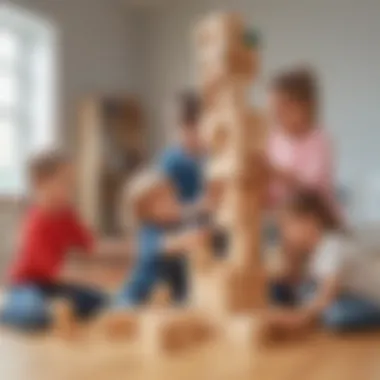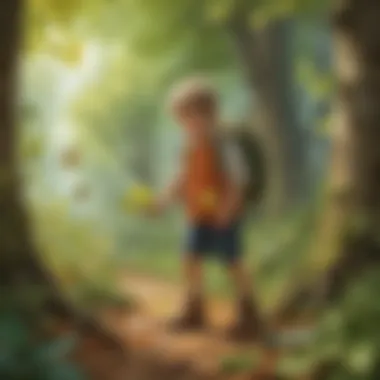Engaging Activities for Six-Year-Olds: Fun Meets Learning


Intro
When it comes to the delicate balance between education and play, six-year-olds are at a pivotal stage. Children of this age are naturally curious and eager to explore the world around them. An engaged six-year-old can transform a simple activity into a rich learning experience. Parents and educators play a crucial role in facilitating this exploration by offering diverse activities that are both fun and educational.
In this guide, we will discuss how to effectively incorporate activities that support creativity, promote problem-solving challenges, and develop scientific thinking skills. Each section will focus on practical suggestions that help foster curiosity and cognitive growth in young minds. Through interactive experiences, we provide insights to enable every caregiver to inspire and educate their children through play.
Science Fun Facts
One engaging way to spark curiosity in young children is presenting fascinating science fun facts. Interesting trivia ignites the imagination and fosters a sense of wonder about the world.
Interesting Trivia and Facts
- Octopuses have three hearts! Two pump blood to the gills, and one pumps to the rest of the body.
- Bananas are berries, but strawberries are not. This surprising fact challenges our intuitive understanding of fruit classification.
- Honey never spoils. Archaeologists have found pots of honey in ancient Egyptian tombs that are over 3000 years old and still perfectly edible.
Quirky Science Stories
Science is filled with bizarre and amusing tales that six-year-olds are sure to remember. For example, did you know there was a crew of cats called “The Nine Lives Crew” on early ship voyages? Equipped with their own set of skills, these felines helped control vermin on ships.
Amazing Science Records
Children enjoy learning about amazing scientific achievements. Consider the ** tallest building in the world is Burj Khalifa in Dubai, standing at 828 meters**. This can lead to discussions about gravity, measurements, and engineering.
Thought-Provoking Questions
Encouraging children to think critically can be engaging when presented with simple, thought-provoking questions:
- What would happen if there were no gravity?
- Why is the sky blue during the day but appears black at night?
- Can you design a home for a polar bear?
Each of these elements not only excites a child's interest but also promotes deeper inquiry.
Discover the Wonders of Science
After piquing the child's interest with facts and stories, the next step is to lead them into active engagement with scientific concepts.
Exploring Various Scientific Concepts
There are many areas of science that can be introduced to six-year-olds in an accessible manner, such as:
- Gravity: Operate simple ramps using various balls and measure how distance changes with angles.
- Weather patterns: Use thermometers and rain gauges to observe daily weather changes together.
- Plants: Slow growth experiments with herbs such as basil or mint can be enlightening.
Educational Videos and Animations
Incorporating bite-sized educational video content can offer a captivating break while still being informative. Websites like Khan Academy Kids provide animated explanations that can stimulate further discussion.
Interactive Learning Tools
Utilizing interactive science apps like Tinybop's
Importance of Fun Activities in Early Childhood Development
Fun activities play a crucial role in the development of six-year-olds. At this age, children begin to explore their surroundings more actively and engage deeply with their peers. Incorporating enjoyable activities not only ignites their natural curiosity but also supports various aspects of growth. When children participate in interactive and playful experiences, they often learn effectively while having fun.
Cognitive Benefits
Engaging fun activities promote cognitive development in significant ways. When six-year-olds partake in challenging games or puzzles, they enhance their problem-solving abilities and critical thinking skills. Children learn to ask questions, seek solutions, and develop logical thinking. Tasks that stress observation, experimentation, and thought exploration prepare their minds for future learning. Simple games like memory challenges or basic scientific experiments with everyday items immerse them in learning without the pressure often associated with traditional education methods.
Social Interaction Skills
Social skills are essential for growing children. Fun activities create opportunities for learning how to communicate, share, and cooperatively interact. Children at this age often start forming friendships, and engaging in group activities helps in developing these social connections. Relay races or team-building games foster experiences that teach them about collaboration and compromise. Moreover, through unstructured play, they learn the art of negotiation and the importance of empathy. Establishing these skills hones their ability to function n a social environment that they will encounter later on in school and life.
Emotional Growth
Play is more than just enjoyment; it has a profound impact on emotional growth. Children learn to express their feelings and manage their emotions through play activities. Fun activities create situations that elicit different emotions such as joy, frustration, or excitement. Engaging in structured and some unstructured play helps them develop emotional regulation, essential for healthy relationships. Being part of a group during these activities also allows children to build self-esteem, as they experience success and overcome challenges. They also learn that mistakes are a valuable part of the learning journey, boosting their resilience as they navigate new situations.
Remember: The blend of learning and play, especially through fun activities, is essential during early childhood. These experiences help prepare young minds not only for formal education but for social and emotional well-being as well.
STEM Activities to Inspire Young Minds
STEM activities play a crucial role in stimulating curiosity and enhancing critical thinking among six-year-olds. Engaging with these topics helps children understand the world through a practical lens. Activities that blend science, technology, engineering, and mathematics not only support intellectual growth but also encourage problem-solving skills. By introducing fun elements in the process, children tend to be more receptive to learning, making these activities essential for their early development.


Simple Science Experiments
Chemical Reactions with Vinegar and Baking Soda
One of the most popular options, chemical reactions using vinegar and baking soda captivate children's interest. This experiment demonstrates simple yet fascinating aspects of chemistry. When mixed, they create carbon dioxide gas, producing an exhilarating fizzing sound that delights young learners.
- Key characteristics: It uses household items, is easy to set up, and is visually appealing.
- Benefits: Encourages scientific inquiry and enhances understanding of reactions while being safe for children.
- Advantages/Disadvantages: The simplicity of the experiment allows it to be repeated easily, though the results can sometimes be unpredictable based on the quantities used.
Water Cycle in a Bag
The Water Cycle in a Bag experiment is a clever way to illustrate the fundamental concept of the water cycle. Children can observe evaporation and condensation right from their homes. When the bag is taped to a sunny window, the water inside heats up, evaporates, and forms droplets, mimicking rain.
- Key characteristic: It visually represents natural processes that occur in the environment.
- Benefits: Encourages observational skills and provides practical knowledge of environmental science.
- Advantages/Disadvantages: Its dependence on sunlight can limit opportunities for observation in cloudy weather, but on a clear day, it can yield compelling results.
Basic Engineering Challenges
Building Structures with Spaghetti
Creating structures using spaghetti provides a tactile learning experience about balance and engineering principles. Children can experiment with various shapes, exploring which designs can withstand the forces acting upon them. It's a straightforward activity that can be adapted for different skill levels.
- Key characteristics: Uses everyday materials, encourages creativity, and fosters teamwork.
- Benefits: The hands-on nature enhances spatial understanding and fine motor skills.
- Advantages/Disadvantages: While easy to execute, weak pasta structures can collapse, which might lead to frustration for some kids unless it's framed as a learning stain with exceptions.
Creating Simple Machines
Simple machines make fundamental engineering concepts accessible to young minds. By utilizing basic materials, children engage in building levers, pulleys, or even inclined planes, introducing them to the principles of mechanical advantage.
- Key characteristics: Offers insight into how machines work and their applications.
- Benefits: Promotes logical thinking and encourages exploration of design principles.
- Advantages/Disadvantages: Effective but requires supervision and patience, as sometimes young builders might struggle with understanding the limits of their creations.
Nature Exploration Activities
Nature Scavenger Hunt
The Nature Scavenger Hunt transforms outdoor time into a thrilling educational experience. By creating a list of items to find in the environment, transition to active exploration daring young learners to observe their surroundings closely.
- Key characteristics: Involves movement, encourages observation, and can be conducted anywhere.
- Benefits: Fosters curiosity about nature and promotes physical activity.
- Advantages/Disadvantages: Flexible list items allow for different levels of challenge. Weather or the absence of certain items may limit the activity.
Plant Growth Observation
Observing plant growth illustrates fundamental biological processes and teaches responsibility. Children can plant seeds in simple containers. Tracking growth through photographs or journals can enhance their analytical skills.
- Key characteristics: Real-time observation of biology makes learning impactful.
- Benefits: Definitely focuses on patience and continuous monitoring, which fosters long-term planning skills.
- Advantages/Disadvantages: Initial observation may take time, and not all seedlings may sprout, which can sometimes be discouraging.
Creative Arts and Crafts Projects
Creative arts and crafts projects are vital for the development of six-year-olds. Engaging in these types of activities fosters creativity and allows children to express themselves. It also sharpens their fine motor skills, as they work with various materials. Moreover, these projects can bring educational aspects into play. By combining fun with learning, children learn concepts in a more engaging way. Such hands-on experiences stimulate their imagination and allow them to solve problems.
Recycling Materials for Crafting
Making Instruments from Household Items
Making instruments from household items enables kids to explore sound and rhythm, fundamental elements of music. This activity encourages them to think resourcefully and be inventive. Common household materials, like containers and rubber bands, can easily be transformed into guitars or drums. The simplicity of this project is a key characteristic that makes it popular.
Unique Feature: Kids learn to identify which objects create sound and which do not, subtly introducing them to concepts of acoustics.
Advantages: This approach involves low-cost materials and promotes recycling, contributing to environmental awareness. Nevertheless, some items might not readily produce expected sounds, which could lead to frustration.
Creating Art with Natural Materials
Creating art with natural materials connects children with nature. Using items like leaves, twigs, and stones fosters appreciation for the environment. This hands-on approach not only nurtures creativity but also introduces basic ecological principles to children.
Key Characteristic: This idea integrates environment and art, making it a valuable choice in the pursuit of holistic learning.
Unique Feature: Artwork created from natural items tends to be unique, encouraging individuality in expressions.
Advantages: Children can observe the seasonal changes in materials they gather. On the downside, natural items can be limited in contrast compared to manufactured supplies.
Incorporating Science into Art
Color Mixing with Water and Paints


Color mixing with water and paints simplifies basic color theory. Children discover primary colors and how they mix to create secondary colors. This fun experiment teaches them cause and effect in an artistic way. The interactive aspect of this activity is particularly beneficial in making science more tangible.
Key Characteristic: Learning about color through play invokes positive emotions and keeps kids engaged.
Unique Feature: The results are immediate, showing children the beauty of combining colors. However, potential mess could deter some caregivers from engaging with this activity.
DIY Volcano Paintings
DIY volcano paintings serve as an exciting way to explore chemical reactions while crafting. By mixing baking soda with vinegar, children create an eruption effect. This captivating visual experience deepens their understanding of processes in nature combined with the satisfaction of artistic expression.
Key Characteristic: This project merges art with science seamlessly, perfect for young, curious minds.
Unique Feature: Kids find immense joy in the explosive aspect of the painting procedure. However, the messiness might be a concern for parents wanting to maintain a tidy home.
Hands-on activities enrich children’s learning by blending creativity with scientific concepts.
Creative arts and crafts projects offer invaluable experiences for developing six-year-olds. The blend of fun and education ensures that children engage while gaining new skills for the future.
Physical Activities to Promote Healthy Habits
Physical activities play a crucial role in fostering healthy habits for six-year-olds. These activities not only encourage physical fitness, but also enhance social interaction and emotional development. Engaging in movement-based activities helps develop coordination, balance, and overall motor skills. Furthermore, it teaches children the importance of teamwork and discipline, laying the groundwork for a balanced lifestyle.
Parents and caregivers can consider a mix of outdoor games and team-building exercises to make physical activity both fun and educational. Maintaining a routine that includes these activities will encourage children to enjoy physical fitness, which is essential in today’s technology-driven world.
Outdoor Games
Outdoor games hold significant value in cultivating physical fitness. They cover vast areas and allow kids to explore while being active. Through fun and varied activities, children improve their strength and resilience, as well as gain a deeper appreciation for the outdoors.
Obstacle Courses
Obstacle courses stand out as a popular choice because they combine various physical tasks such as climbing, crawling, and jumping. The key characteristic of these courses lies in their versatility since they can be created using available resources, like garden items or playground equipment. Their adaptable nature keeps children engaged and challenges them to think creatively.
A major advantage is that they can be tailored to fit different skill levels, ensuring all children feel included. However, parents should supervise to ensure safety, particularly in the arrangement of obstacles.
Nature Yoga
Nature yoga offers a unique approach to merging movement with mindfulness outdoors. This practice encourages children to connect with their surroundings and promotes flexibility and emotional calmness. Nature yoga is distinguished by its ability to incorporate elements of nature, like using the textures of grass or the sounds of birds to enhance the experience.
This activity promotes peacefulness while encouraging children to focus on their breathing and body movement, which is beneficial for personal health. However, it might require timing and practice to ensure children stay attentive and retain interest in poses, particularly if activities become repetitive.
Group Activities for Team Building
Group activities bring an essential aspect of cooperation and connectivity into play. Such experiences are designed to teach collaboration and trust, vital skills for personal and social growth.
Relay Races
Relay races involve teams racing against each other to complete specific events. This achieves dual objectives: improving physical fitness and strengthening cooperative skills. The energy of competition fuels excitement, making sports uplifting and motivational. Relay races are notable not just for their rapid pace, but also for their unique calls for precise baton passing and strategic teamwork. Their engaging structure is likely to unite groups of children under shared goals, although it may necessitate careful observation to maintain fair play among competitive spirits.
Treasure Hunts
Treasure hunts allow for creative problem-solving while promoting exploration. They ignite curiosity and imaginative thinking, essential facets for K-1 intellectual growth. Children work in pairs or small groups, searching for clues and discovering rewards. The captivating element of mystery keeps their engagement high throughout the activity. However, setting clear boundaries for treasure hunt areas becomes critical to ensure their safety as they traverse different spaces.
Encouraging Reading Through Fun
Encouraging reading in young children is key to their overall development. At the age of six, children's cognitive skills are quickly improving, and engaging them through readable content is crucial. Reading enhances language skills, builds vocabulary, and promotes critical thinking. When done in a fun and interactive way, it can shift the perception from reading as a task to reading as play.
Fun reading activities capture interest and encourage deeper engagement with literature. Encouragement from caregivers and educators can foster an enthusiasm for stories. Not only does this help with academic success, but it lays the groundwork for lifelong reading habits. In this section, we will discuss interactive storytelling sessions and book-related activities.
Interactive Storytelling Sessions
Interactive storytelling can turn traditional reading into a dynamic experience. It invites children to participate rather than merely listen. This approach promotes creativity and a deeper understanding of narrative structures. By using props during storytelling, the story comes alive in the minds of the children.
Storytelling with Props
The key feature of storytelling with props is its capacity to stimulate the senses. Props not only visually represent elements within a story but invite children to explore the narrative physically. Kids enjoy handling objects related to the storyline, making them more immersed in the experience.
One unique feature of storytelling with props is the facilitation of imaginative play. For example, using puppets can allow kids to recreate scenes from the book. This method encourages verbal responses and nurtures their expressiveness. However, caregivers should make sure that props are safe and suitable in size for young children, avoiding any choking hazards.
Create Your Own Story Games


Create Your Own Story Games further expands the interaction in storytelling. This activity allows children to become authors of their own tales. They might decide characters, settings, or plot twists. This engagement develops both writing and comprehension skills effectively.
A significant aspect of create your own story games is how it encourages a personal connection with writing. Children see their ideas come to life, enhancing motivation much beyond structured drills. Yet, it requires a initial bit of guidance, as children may not always know where to begin. Caretakers can suggest sentence starters or themes to jump ahead.
Book-related Activities
Work associated with a particular book can strengthen reading comprehension. These activities build literacy skills while being connected to their favorite stories. This strategy leads engaging conversation and fun exploration of literature beyond just reading text.
Crafting Bookmarks
Crafting bookmarks is more than just a handy tool for holding spots in loves books; it becomes an intimate part of the reading experience. Children can express themselves through designing personalized bookmarks, integrating their artistic skills into the process. This combination fosters a sense of ownership for reading material while enhancing fine motor skills as kids create their bookmarks.
Though it’s an enjoyable activity, children may need direction. Having a few templates ready helps them get started quickly. Interesting designs can also serve as great prompts for encouraging additional reading.
Drawing Characters from Favorite Stories
Drawing characters from favorite stories allows for vibrant engagement with literature. Kids relate illustrations to characters. This not only boosts their engagement but also strengthens comprehension and recall. Providing art supplies can help in expanding its influence.
The key feature of this activity is its role in creativity. Drawing encourages expression of how one sees the story visually. Still, children may require support to develop refinement in artistic capabilities. They might need tips and resources that relate simple shapes to complex characters.
]> Creating a positive educational environment is essential in building strong foundations for children enjoying reading. Carefully integrated activities promote learning while still being fun.
Integrating Technology in Learning
In today's increasingly digital world, integrating technology into learning for six-year-olds presents both opportunities and challenges. It is vital to create engaging experiences that blend education with enjoyable use of devices. This integration encourages early exposure to technology, enhancing skill development in mathematics, science, and design. Tools like tablets and computers can diversify traditional play, fostering cognitive thinking and creativity. However, nearby balance is necessary, given the concerns around screen time and content appropriateness.
Educational Apps and Games
Math Puzzle Games
Math puzzle games are interactive activities designed to challenge young learners. These games help children develop essential problem-solving skills and improve their mathematical understanding. A prominent characteristic of math puzzle games is their capacity to offer challenges that are differentiated to each child’s skill level. This adaptability keeps kids engaged without overwhelming them. Additionally, these games can use colorful graphics and clear instructions that captivate children’s attention.
A unique feature of many math puzzle games is the incorporation of rewards and achievements. This engages fun elements foster a sense of accomplishment when children solve problems correctly. Understanding math concepts can be tricky, but these games break down complexities into manageable parts. The slight downside might be maintaining focus on the task. Kids sometimes rush through levels, skipping invaluable learning opportunities one reserves in traditional methods.
Interactive Science Apps
Interactive science apps provide an exciting chance for kids to explore concepts through gameplay. They often promote curiosity and inspire a deeper understanding of scientific principles. Children's favorable aspect of these apps is their capacity to simulate experiments and concepts that might be hard or unsafe to replicate at home. Simply adjusting a variable on the app can demonstrate principles related to physics or biology efficiently.
Many interactive science apps also boast engaging animations. A crucial reason for their advantage is how they allow young learners to explore content at their own pace. Though children's audio prompts and visuals add extra encouragement, a drawback can be the risk of passive learning when users troubleshoot without genuine comprehension. Kids might miss foundational concepts behind the fun if they rely solely on gameplay.
Creating Digital Projects
Building Simple Websites
Building simple websites presents an enjoyable way for children to think creatively while applying critical skills such as organizing content and web design fundamentals. This method offers an invitation to children to share their interests and make projects without being overly complex and intense. Children learn to structure layouts systematically and express ideas clearly through colors and images, which can also strengthen communication skills.
An appealing benefit of building a website is that it fosters a sense of ownership. Crafting a personal space encourages empowerment and pride in one's achievements, boosting their confidence. However, ensuring a safe online experience is essential here. Unsuitable or overwhelming content may lead to frustration rather than motivation.
Creating Digital Storybooks
Creating digital storybooks merges creativity with literature. Children can illustrate their narratives using various digital means, from text to visuals. This experience combats boredom and encourages enthusiastic engagement with stories. A unique characteristic of digital storybooks is their vast canvas of options for personalization, giving children insight into storytelling and loose narrative structures.
These projects stimulate imagination through design and text arrangement, enabling learning outcomes. Unlike traditional storytelling, digital narratives can be populated with multimedia elements that excite learning interactivity. Additionally, online platforms may allow collaborative work. Still, possible downsides may involve children potentially focusing more on digital technology than the story. Balancing story development alongside technical proficiency is the crucial consideration.
Closure: Balancing Fun and Learning
The relationship between fun and learning is integral in early childhood development. In this article, we explore how carefully crafted activities can balance these two essential aspects. Young children, like six-year-olds, thrive in playful environments where learning occurs naturally. A stimulating atmosphere fosters curiosity and enhances understanding of the world.
The Role of Caregivers
Caregivers play a critical role in guiding young learners. Their involvement can shape the outcomes of educational games and activities. Active participation helps reinforce the skills learned during play. When parents or guardians join in, they create meaningful memories while supporting cognitive and social development.
To optimize this interaction, caregivers can:
- Create a safe space for creative play.
- Engage in diverse activities that challenge the child's thinking.
- Encourage peer interactions during group games.
- Assess and adjust activities for the child's skill level.
"Play is the highest form of research." - Albert Einstein
This quote underscores how much children can learn through simple interactions. Caregivers are tasked to provide structured environments where young minds can explore safely. This involvement cultivates trust and shows that learning can be exciting.
Fostering Lifelong Learning
Instilling a mindset of lifelong learning in children is a valuable gift. By blending fun with education, caregivers can pave the path for curiosity and engagement in future pursuits. Activities that combine interests with comfort can promote resilience and adaptability.
Strategies to foster a love of learning in children include:
- Encouraging questions and exploration during activities.
- Showcasing the joy of discovering new concepts through play.
- Varied exposure to topics, from nature walks to arts and crafts.
- Using technology as a tool for creative problem-solving instead of a distraction.







